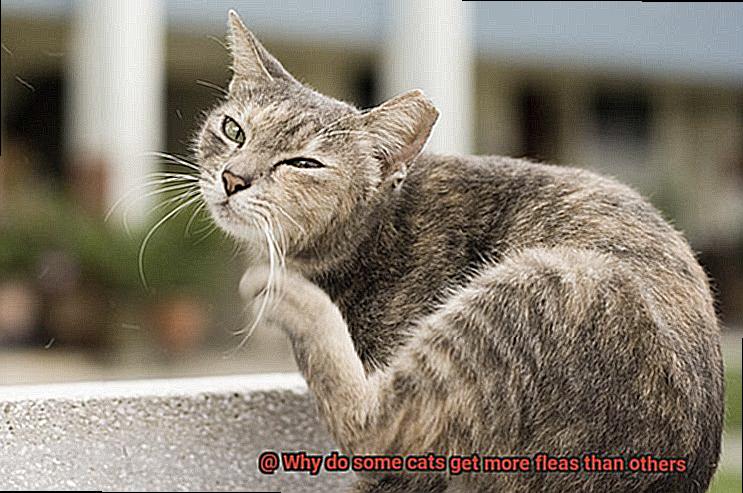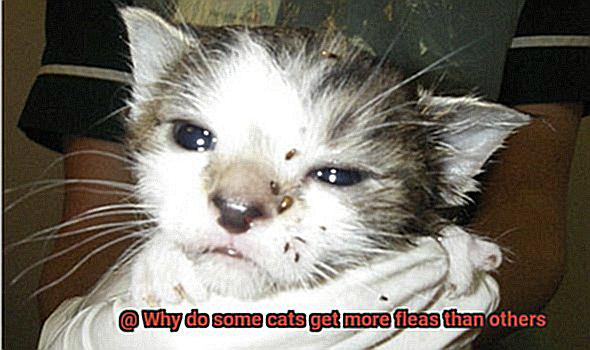As a cat parent, you may have noticed that some feline friends seem to be flea magnets while others never seem to have a problem. It’s a head-scratcher: why do some cats get more fleas than others?
Well, my dear reader, the answer is not as simple as you might assume. The presence of fleas on a cat is not determined solely by breed, age, or coat color. Rather, there are numerous factors that can impact why some cats have higher flea populations than others.
From individual behavior and living situations to environmental factors, we’ll explore the many reasons why some cats are more susceptible to fleas. Additionally, we’ll provide tips on how to manage and prevent fleas from taking over your feline friend’s fur.
Whether you’re an experienced cat owner or just an animal lover with a curious mind, come along with us as we delve into the captivating world of cat fleas and discover what makes some cats more alluring to these pesky parasites than others.
Grooming Habits
One of the most frustrating issues that cats face is flea infestations. But did you know that your cat’s grooming habits could be the key to preventing fleas?
Grooming habits play a crucial role in determining why some cats get more fleas than others. Cats that groom themselves regularly are less likely to have fleas than those who neglect their grooming habits. When cats groom themselves, they remove dead skin cells, dirt, and debris from their fur. These particles can attract fleas, making it easier for them to infest your cat’s coat.
Furthermore, grooming helps distribute natural oils throughout the fur, making it less hospitable for fleas to live and breed. So, if your cat is a grooming fanatic, they are less likely to have fleas. However, older or less mobile cats may have difficulty grooming themselves effectively. These cats may need extra help from their owners to prevent flea infestations.
You can help your cat by regularly brushing and combing their fur. This not only helps remove loose hair and debris but also stimulates the production of natural oils that deter fleas. Additionally, keeping your cat’s environment clean is crucial in preventing flea infestations. Vacuuming regularly and washing bedding and toys can help reduce the number of fleas in the environment and prevent re-infestation.
If your cat has difficulty grooming themselves due to age or health issues such as arthritis or limited mobility, seek veterinary care for further assistance. Remember that prevention is key when it comes to flea infestations in cats.
Activity Level and Lifestyle
These pesky parasites can cause itching, discomfort, and even transmit diseases. But did you know that your feline friend’s activity level and lifestyle can play a crucial role in their likelihood of picking up fleas?
Firstly, let’s talk about outdoor cats. These adventurous felines love to explore their surroundings and often come into contact with other animals and objects that may be carrying fleas. Fleas thrive in warm, humid environments, so if your cat is spending a lot of time in areas with high humidity, the risk of picking up fleas is even higher. Therefore, it is essential to ensure that outdoor cats are regularly treated with flea prevention medication.
What about indoor cats, you ask? Well, while they may be less likely to encounter fleas than their outdoor counterparts, they are not completely immune. Indoor cats can still pick up fleas from visiting humans or other pets, and if their environment is not properly cleaned or maintained, it can become a breeding ground for fleas. So make sure to keep your indoor cat’s living space clean and tidy.
But it’s not just the living environment that matters – a cat’s activity level also plays a significant role in their susceptibility to flea infestations. Highly active and playful cats are more likely to come into contact with other animals and objects that may be carrying fleas. Additionally, cats that live in multi-cat households or in close proximity to other animals are at a higher risk for flea infestations.
So what can cat owners do to prevent flea infestations? First and foremost, regular flea treatments are essential for all cats, regardless of their activity level or lifestyle. Additionally, keeping your cat’s living space clean and tidy can go a long way in preventing flea infestations. Vacuuming carpets and furniture regularly, washing bedding frequently, and disposing of any flea-infested items can all help keep fleas at bay.
Age and Health of a Cat
One potential issue that can arise is the dreaded flea infestation. While fleas may seem like nothing more than a minor annoyance, they can pose serious health risks for cats. That’s why understanding how age and health can impact the likelihood of a flea infestation is so important.
For starters, older cats or those with compromised immune systems may be more vulnerable to flea infestations. Their bodies are simply not as equipped to fight off pests as younger or healthier cats. Additionally, cats with pre-existing health issues may be less likely to groom themselves properly, which can leave them more susceptible to fleas. Fleas thrive in warm and humid environments, so if a cat is already feeling unwell and neglecting their hygiene, it creates an ideal environment for fleas to thrive.

But even young and healthy cats aren’t immune to fleas. That’s why taking care of your cat’s overall health and well-being is essential. Regular check-ups with a veterinarian can help identify any underlying health issues that may make your cat more vulnerable to flea infestations. Feeding your cat a healthy diet can also go a long way in keeping them healthy and flea-free.
It’s also important to keep your cat’s living space clean and tidy. Regular vacuuming of carpets and furniture, washing bedding, and keeping the litter box clean can all help prevent flea infestations. If you do notice fleas on your cat, don’t panic. Effective flea treatments are available that can help get rid of these pesky pests.

Environment
One of the most significant concerns when it comes to cats is flea infestations. These pesky parasites can cause serious discomfort and pose a threat to your cat’s overall health. So, how exactly does the environment impact flea populations in cats? Let’s take a closer look.
First and foremost, fleas thrive in warm, humid environments. If your cat spends a lot of time outdoors in hot and humid weather, they are more likely to come into contact with fleas and bring them home. Additionally, if you live in an area with a high flea population, your cat is at a greater risk of getting fleas. This is why it’s important to be mindful of your cat’s environment and take preventative measures such as using flea treatments.
Another environmental factor that can impact flea populations is the cleanliness of your home. Fleas lay their eggs in carpets, bedding, and furniture, so regular cleaning can help prevent an infestation. Vacuuming carpets and washing bedding frequently can help reduce the risk of flea larvae developing in your home. If you have multiple pets, it’s essential to treat all of them for fleas since they can easily spread from one animal to another.
Moreover, some cats may have sensitivities to certain environmental factors that attract fleas. For example, if your cat has allergies or a weakened immune system, they may be more attractive to fleas than a healthy cat. Stress can also play a role in flea infestations since it weakens the immune system and makes cats more susceptible to parasites.
Prevention Measures
While some cats may be more susceptible to fleas than others, there are steps you can take to prevent an infestation from occurring.
Keeping your cat’s environment clean is one of the most critical prevention measures. Fleas thrive in dirty and dusty areas, so make sure to clean your cat’s bedding and litter box frequently. Vacuuming carpets and furniture regularly can also help reduce the risk of a flea infestation.
Another effective prevention measure is giving your cat regular baths with flea shampoo. This will not only kill any fleas that may be on their fur but also prevent new ones from attaching. Just be careful not to overdo it with the baths, as it can dry out your cat’s skin.

Flea medication is also crucial in preventing a flea infestation. From topical treatments to oral medications, there are many options available. Consult with your veterinarian to determine the best option for your cat based on their age, weight, and overall health.
In addition to keeping your cat flea-free, it’s important to ensure that your home and yard are flea-free as well. Use flea sprays or foggers in areas where your cat spends time, such as their bedding or play area. Keeping your yard trimmed and removing any debris or piles of leaves where fleas can hide can also help keep fleas at bay.
To summarize, here are the prevention measures you can take to keep your cat flea-free:
- Keep your cat’s environment clean by cleaning their bedding and litter box regularly
- Give your cat regular baths with flea shampoo
- Use flea medication as recommended by your veterinarian
- Ensure that your home and yard are flea-free by using sprays or foggers and removing any debris
Symptoms of Flea Infestation in Cats
Fleas may be tiny, but they can cause big problems for your feline friend. As a responsible cat owner, it’s crucial to know the signs of flea infestation and take action before it becomes a serious health issue. Here are some key symptoms to look out for:
Excessive scratching and grooming are among the most common signs of flea infestation in cats. Flea bites are incredibly irritating and itchy, leading your cat to groom themselves more often than usual to relieve discomfort. Pay attention to any redness or irritation on their skin, as well as hair loss or hot spots.
Flea dirt is another telltale sign of infestation. This looks like small black specks on your cat’s fur and is actually dried blood that has been excreted by fleas. Check your cat’s bedding and skin for these specks, especially around the neck, tail, and back legs.
In severe cases, fleas can lead to anemia in cats – a condition where there is a decrease in red blood cells. This is particularly dangerous for young or weak cats, causing lethargy, weakness, and pale gums. If you notice any of these symptoms, seek veterinary care immediately.
Fleas can also transmit diseases to cats such as tapeworms and cat scratch fever. Keeping your home clean and vacuumed regularly can help reduce the risk of flea infestations in your cat. Additionally, use preventative measures such as regular flea treatments to keep your furry friend safe and healthy.
Treatments for Fleas on Cats
There are many effective treatments available to help get rid of fleas on cats.
Topical flea medication is one of the most popular treatments available. These easy-to-use medications are applied directly to the skin on the back of your cat’s neck and work by killing fleas upon contact. Some top-rated topical flea medications include Frontline, Advantage, and Revolution. You can purchase these medications from your veterinarian or at pet stores without a prescription.
Another option for treating fleas on cats is oral medication. These medications prevent flea eggs from hatching, which helps break the flea life cycle. Capstar is one of the best oral flea medications for cats as it starts working within 30 minutes and quickly kills fleas.
For a more traditional approach, flea collars are also available for cats. These collars work by releasing a small amount of insecticide that kills fleas on contact. Two popular flea collars for cats are Seresto and Hartz.
It’s important to note that not all flea treatments are safe or effective for every cat. Before starting any treatment regimen, always consult with your veterinarian to ensure it’s right for your furry friend.
In addition to treating your cat for fleas, it’s equally important to treat your home and yard to prevent re-infestation. Regular vacuuming, washing bedding in hot water, and using flea sprays or foggers can help eliminate fleas in your home. Outdoor areas should also be treated with flea control products.
The Dangers of Fleas for Cats
Fleas are not just pesky insects for cats – they can be a serious threat to their health. These tiny parasites feed on blood, and if left untreated, they can cause anemia in cats, especially in kittens or older cats. Anemia is a condition that results in low levels of red blood cells and can lead to lethargy, weakness, and even death.
In addition to anemia, fleas can also cause skin irritations and infections in cats that are allergic to flea saliva. Constant scratching and biting can lead to hair loss, skin lesions, and a severe allergic reaction known as flea allergy dermatitis (FAD). FAD is a common condition among cats that causes intense itching and discomfort.
But that’s not all – fleas can also transmit diseases to cats. For instance, cat scratch fever, tapeworms, and even the bubonic plague are all diseases that can be transmitted by fleas. These diseases can be fatal if left untreated, making flea prevention crucial for every cat owner.
So how can you protect your cat from fleas? Regular grooming and hygiene practices like bathing and brushing can help eliminate any fleas or eggs already present on the cat’s fur. Using flea preventative products such as topical treatments or collars will also keep fleas away.
To ensure the complete removal of fleas from your home, it’s important to clean and vacuum regularly. Flea eggs and larvae can be found in areas where your cat spends time, such as bedding or furniture. By cleaning these areas frequently, you can reduce the chances of a flea infestation.
w2fzZKl1IXw” >
Conclusion
In conclusion, the presence of fleas on cats is a complex issue that cannot be attributed to breed, age, or coat color alone. A combination of factors such as grooming habits and living conditions can significantly impact flea populations in cats. For instance, highly active and playful felines are more likely to come into contact with other animals and objects that may carry fleas.
Moreover, environmental factors such as warm and humid weather conditions can increase the risk of flea infestations in outdoor cats. Even indoor cats are not completely safe from fleas since they can pick up these parasites from visiting humans or other pets if their environment is not properly cleaned or maintained.
Flea medication is a crucial preventive measure against flea infestations in all cats. Fleas pose serious health risks for our furry friends, including anemia, skin irritations and infections, as well as transmission of diseases such as cat scratch fever and tapeworms.
Regular grooming practices like bathing and brushing can help eliminate any fleas already present on the cat’s fur. Additionally, using flea preventative products such as topical treatments or collars will keep fleas at bay. To ensure complete removal of fleas from your home, it’s important to clean and vacuum regularly since flea eggs and larvae can be found in areas where your cat spends time.
By taking preventive measures against fleas, you can keep your feline friend healthy and happy.







